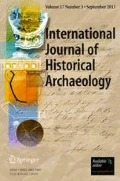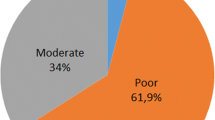Abstract
This paper presents the first investigation of animal remains unearthed from the Late Ottoman occupation at Mardin fortress, a military stronghold in Anatolian–Syrian frontier under Ottoman rule. The analysis produced 4234 specimens and carried out taxonomic identification, species diversity, kill-off patterns, and nature of bone modification, including those of taphonomic and cultural marks. Being the first zooarchaeological study of an Ottoman occupation in southeastern Anatolia, the results add vital information to the paucity of archaeological knowledge of life and dietary habits of regional Ottoman elite soldiers, and offer a glimpse into the local pastoralism and wildlife of that time.
















Similar content being viewed by others
Data Availability
The Ottoman faunal remains from Mardin fortress are presently a part of the collections of the Zooarchaeology Laboratory, Department of Anthropology, Mardin Artuklu University, Turkey. The assemblage or part of it is available for further study via application through the General Directorate of Cultural Heritage and Museums, Ministry of Culture and Tourism, Republic of Turkey.
References
Akgündüz, A. (1990). Osmanlı Kanunnameleri ve Hukuki Tahlilleri: II. Beyazid Devri Kanunnameleri. FEY Vakfı yayınları, İstanbul, Turkey.
Armutak, A., Öncü, Ö. E., Erdoğdu, A., and Onar, V. (2020). Animal skeletal remains recovered from the Harem (Concubine’s) hospital and the black eunuchs’ ward at the Topkapı Palace, Istanbul, Turkey. Journal of Archaeological Science: Reports 34: 102586. https://doi.org/10.1016/j.jasrep.2020.102586
Artan, T. (2000). Aspects of the Ottoman elite’s food consumption: looking for “staples,” “luxuries,” and “delicacies” in a changing century. In Quataert, D. (ed.), Consumption Studies and the History of the Ottoman Empire, 1550–1922: An Introduction. State University of New York Press, Albany, pp. 107–200.
Baker, J. R. and Brothwell, D. R. (1980). Animal Diseases in Archaeology. Academic Press, London.
Baram, U. and Carroll, L. (eds.) (2000). A Historical Archaeology of the Ottoman Empire: Breaking New Ground. Kluwer Academic/Plenum Publishers, New York.
Barone, R. (1999). Anatomie Comparee des Mammiferes Domestiques, Tome premier: Osteologie. Vigot Freres, Paris.
Boessneck, J. (1969). Osteological differences between sheep (Ovis aries Linnè) and goat (Capra hircus Linnè). In Brothwell, D. and Higgs, E. (eds.), Science in Archaeology: A Comprehensive Survey of Progress and Research. Thames and Hudson, London, pp. 311–358.
Clason, A. T. (1972). Some remarks on the use and presentation of archaeozoological data. Helinium 12(2): 139–153.
Cohen, A. and Serjeantson, D. (1996). A Manual for Identification of Bird Bones from Archaeological Sites. Archetype, London.
Deniz, E. and Payne, S. (1979). Eruption and wear in the mandibular dentition of Turkish Angora goats in relation to ageing sheep/goat mandibles from archaeological sites. In Kubasiewicz, M. (ed.), Archaeozoology, Volume I. Agricultural Academy, Szczecin, Poland, pp. 153–163.
Dinç, F. and Yeşilbaş, E. (2022). Mardin. In Bakanlığı Ç. Ş. (ed.), Türklerde Çevre ve Şehircilik, Vol. II. Çevre ve Şehircilik Bakanlığı Yayınları, Ankara (in press).
Elmaz, Ö. and Saatcı, M. (2017). Turkish hair goat, the main pillar of goat population in Turkey. In Simões, J. and Gutiérrez, C. (eds.), Sustainable Goat Production in Adverse Environments: Volume II. Springer, New York, pp. 113–130. https://doi.org/10.1007/978-3-319-71294-9_9
Ersoy, A. (2017). Antik Dönemden Osmanlı Ddönemine Smyrna/İzmir Kemik Objeleri. Ege Yayınları, İstanbul.
Faroqhi, S. (ed.) (2010a). Animals and People in the Ottoman Empire. Eren, Istanbul.
Faroqhi, S. (2010b). Means of transportation and sources of pride and joy: horses in the hands of Ottoman officials and notables. In Faroqhi, S. (ed.), Animals and People in the Ottoman Empire. Eren, Istanbul, pp. 293–312.
Fisher, J. W. (1995). Bone surface modifications in zooarchaeology. Journal of Archaeological Method and Theory 2(1): 7–68. https://doi.org/10.1007/BF02228434
Göyünç, N. (1991). XVI. Yüzyılda Mardin Sancağı. Türk Tarih Kurumu Basımevi, Ankara.
Gündoğdu, C. (2020). Dogs feared and dogs loved: human-dog relations in the Late Ottoman Empire. Society and Animals 2020: 1–22. https://doi.org/10.1163/15685306-BJA10008.
Gürhan, V. (2015). XVIII. Yüzyılda Mardin kalesi üzerine bazı tespitler. Şarkiyat 7(2): 219–233.
Gürler, A. M., Meli̇koğlu, B., and Osmanağaoğlu, Ş. (2011). A historical evaluation of animal protection efforts of non-governmental organizations in Turkey. Kafkas Üniversitesi Veterinerlik Fakültesi Dergisi 17(6): 901–908. https://doi.org/10.9775/kvfd.2011.4665.
Gürler, B., Ersoy, A., and Ersoy, G. Ç. (2016). İzmir’in Osmanlı Dönemi Tanıkları Smyrna/İzmir Agorasından Cam Objeler. İzmir Büyükşehir Belediyesi Yayınları, İzmir, Turkey.
Halstead, P., Collins, P., and Isaakidou, V. (2002). Sorting the sheep from the goats: morphological distinctions between the mandibles and mandibular teeth of adult Ovis and Capra. Journal of Archaeological Science 29(5): 545–553. https://doi.org/10.1006/jasc.2001.0777
Hillson, S. (2005). Teeth. Cambridge University Press, Cambridge.
Hongo, H. (1997). Patterns of animal husbandry, environment, and ethnicity in central Anatolia in the Ottoman Empire period: faunal remains from Islamic layers at Kaman-Kalehöyük. Japan Review 8: 275–307.
Hütteroth, W.-D. (2006). Ecology of the Ottoman lands. In Faroqhi, S. N. (ed.), The Cambridge History of Turkey. Cambridge University Press, Cambridge, pp. 18–43. https://doi.org/10.1017/CHOL9780521620956.003
Kasaba, R. (2009). A Moveable Empire: Ottoman Nomads, Migrants, and Refugees. University of Washington Press, Seattle.
Lyman, R. L. (2008). Quantitative Paleozoology. Cambridge University Press, Cambridge. https://doi.org/10.1017/CBO9780511813863
Moran, N. C. and O’Connor, T. P. (1992). Bones that cats gnawed upon: a case study in bone modification. Circaea 9(1): 27–34.
Moran, N. C. and O’Connor, T. P. (1994). Age attribution in domestic sheep by skeletal and dental maturation: a pilot study of available sources. International Journal of Osteoarchaeology 4(4): 267–285. https://doi.org/10.1002/oa.1390040402
Murphey, R. (1984). Some features of nomadism in the Ottoman Empire: a survey based on tribal census and judicial appeal documentation from archives in Istanbul and Damascus. Journal of Turkish Studies 8: 189–197.
Popkin, P., Baker, P., Worley, F., Payne, S., and Hammon, A. (2013). The Sheep Project (1): determining skeletal growth, timing of epiphyseal fusion and morphometric variation in unimproved Shetland sheep of known age, sex, castration status and nutrition. Journal of Archaeological Science 39(6): 1775–1792. https://doi.org/10.1016/j.jas.2012.01.018
Şanlı, S. and Siddiq, A. B. (2018). Anthrozoological study on the agro-pastoral societies of Kiziltepe, southeast Anatolia. İnsan ve İnsan 5(16): 121–138. https://doi.org/10.29224/insanveinsan.378568
Sevin, V., Sevin, N. A., and Kalsen, H. (2011. Harput: Kale Mahallesinde Osmanlı Yaşamı. Ege Yayınları, Istanbul.
Siddiq, A. B. (2017). Pastoral societies of Mardin province in southeast Turkey – some anthrozoological aspects. Mukaddime 8(2): 253–265. https://doi.org/10.19059/mukaddime.296314
Siddiq, A. B. (2019). Tarihöncesi Toplumlarda Insan-Hayvan Iliskisi ve Orta Anadolu Çanak Çömleksiz Neolitik Dönem Faunasi. Çizgi Kitabevi, Konya, Turkey.
Siddiq, A. B., Erdem, Ç. and Şanlı, S. (2018). Adoption and abandon of camel culture in southeast Anatolia. In Ertürk, D. and Gökdemir, Ö. (eds.), Second International Selçuk-Ephesus Symposium on Culture of Camel-Dealing and Camel Wrestling. Vol. I: Social Science. Selçuk Efes Kent Belleği Yayınları, Selçuk, Izmir, Turkey, pp. 228–241.
Siddiq, A. B. and Şanlı, S. (2020). Animals and pastoral groups in the mountainous Ömerli district of southeast Anatolia. Anthrozoös 33(2): 153–173. https://doi.org/10.1080/08927936.2020.1719754
Solari, A., Olivera, D., Gordillo, I., Bosch, P., Fetter, G., Lara, V. H., and Novelo, O. (2015). Cooked bones? method and practice for identifying bones treated at low temperature: physical techniques may be used to verify low-temperature cooked bones. International Journal of Osteoarchaeology 25(4): 426–440. https://doi.org/10.1002/oa.2311
Stevanović, O., Janeczek, M., Chrószcz, A., and Marković, N. (2015). Joint diseases in animal paleopathology: veterinary approach. Macedonian Veterinary Review 38(1): 5–12. https://doi.org/10.14432/j.macvetrev.2014.10.024
Usta, O. (2016). In Pursuit of Herds or Land? Nomads, Peasants and Pastoral Economies in Anatolia from a Regional Perspective 1600–1645. Doctoral dissertation, University of Birmingham, Birmingham.
von den Driesch, A. (1976). A Guide to the Measurement of Animal Bones from Archaeological Sites. Peabody Museum of Archaeology and Ethnology, Harvard University, Cambridge, MA.
Wilson, B., Grigson, C., and Payne, S. (eds.) (1982). Ageing and Sexing Animal Bones from Archaeological Sites. University of Michigan Press, Ann Arbor. https://doi.org/10.30861/9780860541929
Yılmaz, O., Wilson, R. T., Aşkın, K., Fırat, C., and Mehmet, E. (2012). The farm animal genetic resources of Turkey: sheep – I – common and rare breeds. Bitlis Eren University Journal of Science and Technology 2: 1–5.
Zeder, M. (2006). Reconciling rates of long bone fusion and tooth eruption and wear in Sheep (Ovis) and Goat (Capra). In Ruscillo, D. (ed.), Recent Advances in Ageing and Sexing Animal Bones. Oxbow, Oxford, pp. 87–118. https://doi.org/10.2307/j.ctvh1ds02
Zeder, M. A. and Lapham, H. A. (2010). Assessing the reliability of criteria used to identify postcranial bones in sheep, Ovis, and goats, Capra. Journal of Archaeological Science 37(11): 2887–2905. https://doi.org/10.1016/j.jas.2010.06.032
Zeder, M. A. and Pilaar, S. E. (2010). Assessing the reliability of criteria used to identify mandibles and mandibular teeth in sheep, Ovis, and goats, Capra. Journal of Archaeological Science 37(2): 225–242. https://doi.org/10.1016/j.jas.2009.10.002
Acknowledgments
The author presents sincere acknowledgments to the directorate of Mardin Museum for the permission to study the assemblage. The author is grateful to Vedat Onar and Simon Davis for their help in the identification of buffalo bones. The author sincerely thanks to Evindar Yeşilbaş, Çağdaş Erdem, Ayşe Acar, Süleyman Şanlı, Güler Oğuz, Muhammed Eyyub Dalar, and Ferhat Kaya for their support during the study. The author especially would like to thank the anonymous reviewers for their valuable comments, as well as Eric Tourigny and Rebecca Gordon for editing the manuscript.
Funding
This research was partially suppoted by a research grant funded by the Mardin Artuklu University Scientific Research Projects Commission (Project No. MAÜ.BAP.20.EF.011).
Author information
Authors and Affiliations
Corresponding author
Ethics declarations
Conflict of Interest
The author has no relevant fnancial or non-fnancial interests to disclose in the subject matter or materials discussed in this study.
Additional information
Publisher’s Note
Springer Nature remains neutral with regard to jurisdictional claims in published maps and institutional affiliations.
Rights and permissions
About this article
Cite this article
Siddiq, A.B. Common Animals for Elite Humans: the Late Ottoman Fauna from Mardin Fortress, Southeastern Anatolia (Turkey). Int J Histor Archaeol 27, 316–347 (2023). https://doi.org/10.1007/s10761-022-00657-4
Accepted:
Published:
Issue Date:
DOI: https://doi.org/10.1007/s10761-022-00657-4




